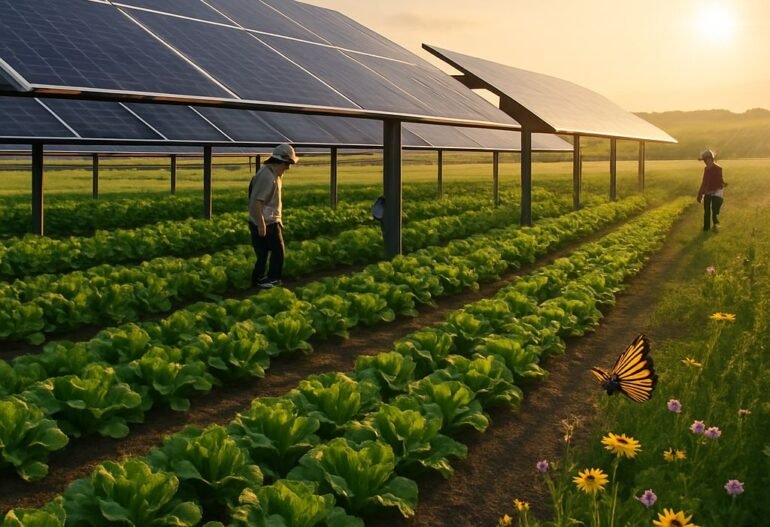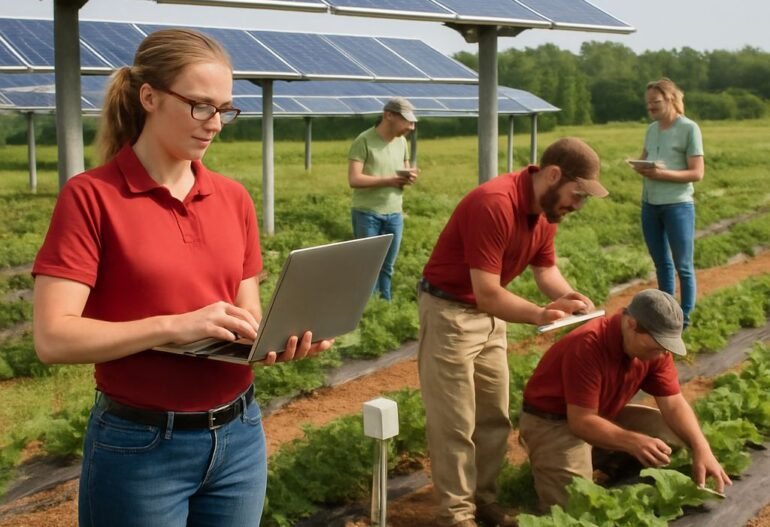Over the past few years, a subdued yet revolutionary revolution has been taking place in the agricultural environment as renewable energy technologies have been integrated into the daily farming operations. Agrivoltaics, which combines agriculture with solar energy production, can be one of the brightest innovations. This dual-use model is gaining traction nationwide, and Iowa, with its extensive farmlands and growing emphasis on sustainability, is emerging as a leader in this area. However, how is it that solar panels are aiding crop growth, and what is the science behind that seemingly counterintuitive development? Agrivoltaics is a globally fascinating field, as it is revolutionizing farming in Iowa. Let us take a closer look at it.
What is agrivoltaics?
Agrophotovoltaics (commonly referred to as agrivoltaics) is the co-location of solar panels and crops on the same area. Rather than competing in utilizing the space, these two systems will be able to work, constituting a win-win scenario to farmers and proponents of renewable energy.
It is a straightforward and strong idea: Solar panels are mounted at a considerable height or with adjustable angles to enable sunlight to go through or around the panels. This installation has created shade for the crops but is capable of creating clean electricity. Farmers can balance the light distribution and be able to grow some crops with more efficiency, and harvest solar energy at the same time.
Why Iowa Is a Perfect Fit for Agrivoltaics
Iowa, also known as the Corn State, is a state that is synonymous with agriculture. It also has rich lands with extensive farmlands, which have made it one of the largest corn, soybean, etc producers in the U.S. Nevertheless, Iowa is also a state with radical climatic conditions, making it scorchingly hot in summer and locally very stormy. The constraints raise interest in agrivoltaics as a possible method to construct climate-adaptive farms.
Also, Iowa has remained with a pioneering spirit of renewable energy, especially wind energy. Since the state is seeking to diversify its clean energy sources, solar power is increasingly becoming appealing. Agrivoltaics helps farmers embrace solar power without having to trade in precious farmland by increasing profitability and sustainability.
The Science Behind Agrivoltaics
- Microclimate Modification
The second advantage of agrivoltaics is the establishment of a more microclimate-friendly to crops. The solar panel can inhibit or limit direct sunlight by shading crops partly, thus alleviating the effect of water loss through evaporation due to the reduction of direct sunlight. This is more so, especially in other areas such as Iowa, where the summers may be dry and hot.
Research has indicated that some crops, e.g., lettuce, spinach, and tomatoes, grow well in partial shade conditions. The plants can absorb less of the direct sun to photosynthesize and take advantage of the cool soil temperatures and or less water needs.
- Water Conservation
The issue of water shortage in agriculture has been on the rise even in states such as Iowa, where rainfall is normally plentiful. Alternatives such as using solar panels will also address this problem because the rate of evaporation is likely to be slowed down. The ground will attract moisture by the shade the panels offer, which reduces the necessity of irrigation. Other agrivoltaic systems use panels to capture rainwater, helping to sustain more water-efficient agriculture too.
- Increased Land Yield
There is a common conflict in terms of land use where solar power generation clashes with traditional farming. Agrivoltaics eliminates this conflict by integrating both of them on the same land. This is a dual-use strategy which improves the productivity of land as a whole, and it is of utmost importance in a state like Iow, where land is scarce but vital at the same time.
- Pollinator Support
Numerous agrivoltaics will have pollinator-friendly plantings under the solar arrays. These are the plants that attract bees and butterflies, among others, that are important as crop producers. Through the creation of a beneficial ecosystem for pollinators, agrivoltaics leads indirectly to increased yields, contributing to biodiversity.

Real-World Agrivoltaic Applications in Iowa
Pilot Projects and Research
Other institutions, such as Iowa State University, are in the forefront of conducting research in agrivoltaic through field trials that will help determine different crop performances in the presence of a solar system. Recent experiments discovered that crop vegetables (pepper and squash), which are sensitive to heat or drought, responded well to planting in partial shade under panels.
Farmer-Led Initiatives
The progressive Iowa farmers are incorporating agrivoltaics in their farms. The systems, in addition to the production of renewable energy, enhance the resilience of crops and lower the cost of inputs. Testimonies by farmers include a decrease in irrigation requirements as well as less fluctuating crop production in extreme heat.
Cooperative Model and Community Solar
Local solar co-ops and shared land-use projects involving local agrivoltaic adoption take place in some Iowa communities. Farmers and residents can enjoy this new system and provide a functional use of working farmland by using these models.
Challenges and Considerations
Even though this is a promising development, agrivoltaics is not without its problems:
- Compatibility with Crops Crop shades are not compatible with all crops. The best combinations should be discovered during research.
- Complexity of System Design: The height of the panels, spacing, and orientation should be maximized in terms of growing crops, as well as the generation of energy.
- Initial Investment: Initial capital can be costly as installation is involved, and grants and incentives are helpful to reduce the cost.
- Operations and Maintenance: There is a need to coordinate both agriculture and energy systems, and have knowledge on how to operate them.
Frequently Asked Questions (FAQs)
Will every crop be able to be cultivated under solar panels?
Not every crop can be optimal in agrivoltaic systems, no. Partial shade is crucial to shade-tolerant crops such as lettuce, spinach, peppers, and squash, which are heat sensitive.
Does a solar panel impact crop production?
Yes – they can enhance the production of some crops by alleviating the problem of heat stress and saving on water in most instances. It has been demonstrated that some vegetables perform better when grown under the shade of the solar panels in Iowa.
Is agrivoltaics appropriate to the climate of Iowa?
Definitely. Iowa summers are blistering, and the weather is unpredictable, which makes it a good prospect. Solar panels can also help crops avoid drought and unbearable heat due to partial shading.
What is the price of an agrivoltaic system?
The prices differ according to the size of the system and the design. The amount of money needed to invest upfront is more than that needed in the case of traditional farming, but many farmers compensate for this by saving on energy, tax exemption, and USDA grants.
Do we have any financial incentives to agrivoltaics?
Yes. The support is available through programs such as the Rural Energy for America Program (REAP) created by the USDA and clean energy grants offered by several states to those farmers who introduce agrivoltaic systems.
The Future of Agrivoltaics in Iowa
As more people become interested in agrivoltaics, innovation also increases. The efficiency of these systems is enhanced by bifacial solar panels, which absorb sunlight on both sides, tracking systems that follow the sun, and advanced monitoring technologies.
Agrivoltaics are becoming more achievable by federal and state programs, such as the USDA Rural Energy for America Program (REAP). During the worsening of climatic changes, such an opportunity to develop resilient, two-purpose farms will be essential.
Iowa has cultivated an agriculture and renewable energy leadership that, once combined with other technologies such as agrivoltaic integration, makes it a role model state nationwide.
Conclusion
Agrivoltaics is the disruptive union of healthy agriculture and renewable energy. This solution is working in the state of Iowa, where the farm and renewable innovation have a traditional union and are demonstrating that we do not need to make a trade-off between food and energy; we can achieve both.
Capitalizing on solar panels to establish microclimates, save water, and optimize land, farmers in Iowa are establishing a new age of climate-smart agriculture. With more technology and support, agrivoltaics will become essential in food security, energy independence, and environmental stewardship.
It is not only the sun that is fuelling our home, but it is also contributing to global sustainable agricultural growth because it is making crops stronger, smarter, and sustainable.




